National Maritime Museum 1930s Festival
Report written by Peter Clay for our June 2010 Newsletter
Saturday 1 May 2010
National Maritime Museum
Greenwich
On 1st May 2010 members of SELMEC put on an exhibition at the National Maritime Museum, undoubtedly the most prestigious venue this club has attended. This was at the invitation of the museum’s Public Programmes Co-ordinator Sarah Hicks, and tied in with their 1930s themed festival celebrating the opening of their new Toy Boats exhibition.
I arrived to find members already busy setting up, with Frank Paine arranging one of his superb montages. We exhibited in the entrance hall of the museum by the bookshop in an area professionally roped off for us. An enormous ship’s propeller was rotating above (directly over my head!) It was possible to see our entire exhibition from the gallery above.
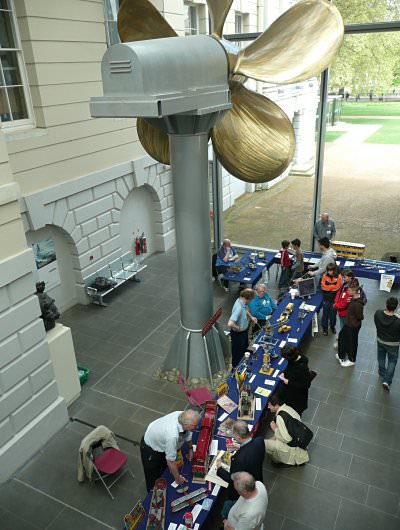
A view of our exhibition from the gallery
The museum seems to have been considerably expanded and refurbished since I last visited and it must be the first time I have not been able to see the observatory and clocks. The new Toy Boats exhibition included Meccano, Hornby and Dinky items, together with three working hands-on examples of model boat propulsion, two of which were out of action! How unlike our models!
However — on to what you really want to know: Our models, in order from the front window inwards, were as follows:
Chris Warrell had his HR1 London tramcar. This model, three feet long, ran throughout the exhibition along ten feet of track. I could see that for many young visitors this model provided the real WOW! factor. Adults, as well as museum staff, were as fascinated — and this must be said of the whole exhibition. Chris also brought three ship models in blue and gold, from outfits 3 and 4 of the time — a submarine, a battle cruiser and river gun boat.
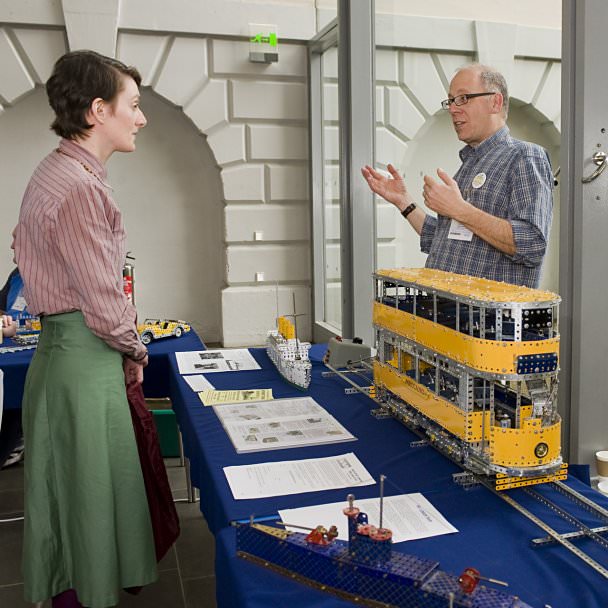
Chris Warrell boring a poor woman to death! (Photo: NMM)
Adrian Ashford was unable to attend since he was in Welling running his Hornby Trains exhibition. He did however also show a ship — the liner ‘Empress of Britain’, which was beautifully made in a striking, predominantly white colour scheme.
Chris Fry showed Bernard Perier’s Triumph open sports car sporting spoked wheels and well detailed. Also from that Gallic wizard he had a miniature (O gauge?) railway breakdown crane, hand operated but with all movements working. From the same source was an open MG sports car. He also had a small car with rotating spoked wheels mounted on a display stand. Not content with all this he showed the SML steam shovel, with an improved gear box and a dummy steam plant powered by an electric motor: another model, running throughout the day, to the fascination of spectators. Visitors were also intrigued by his ‘hands-on’ inertial unidirectional mechanism.
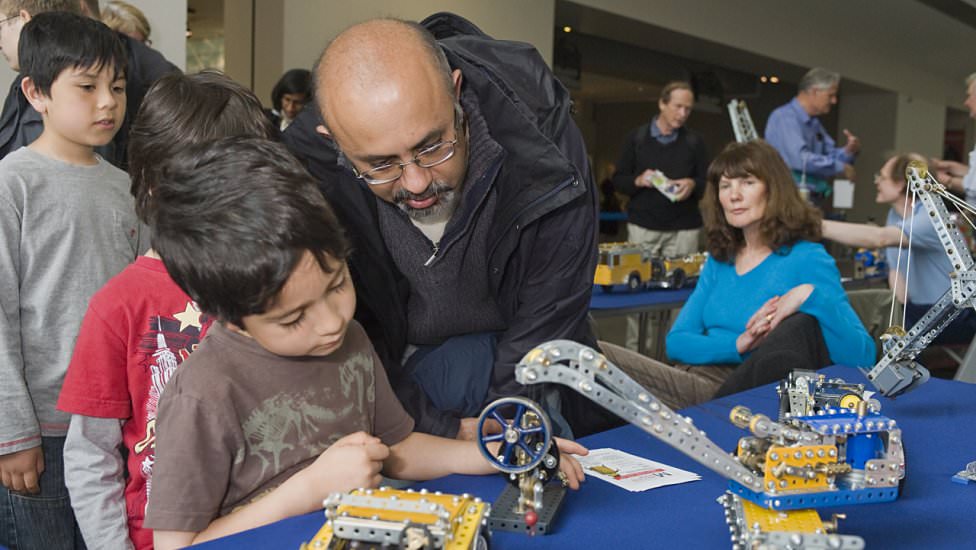
A family are fascinated by Chris Fry’s models (Photo: NMM)
Tim Surtell always does us proud on the publicity front. He had a continuously running laptop display of 1930s models, Meccano Magazine covers etc. including SELMEC models. This was also visible on a large screen behind the club’s display. I think the museum downloaded it for their own use. Tim also designed the new posters for our October exhibition which were, of course, on display.
Peter Clay had a 1930s touring car and caravan from the 1935 Meccano Magazine series ‘In search of new models’, built from the photographs and description (as no detailed instructions were given). It looked good in a yellow, silver and black colour scheme with plenty of brassware for the lights, horn, etc. The tapering chassis and bodywork made it difficult to build and it was not possible to motorise it. A foundry hand-operated portable crane from 1930s manual proved popular with children, who liked winding up the hook until it was jammed at the top! Turning a crank does not come naturally to the youth of today. My Goliath Pioneer 3-wheeled German light car, fitted with an electric motor, had a tight turning circle enabling it to be run around on the table top, probably at scale speed as the original had a 1-cylinder 2-stroke engine! Also shown were a small sports car and ‘Dad’s Army’ van.
Brian Elvidge brought a level-luffing crane, worked by hand, from an Meccano Magazine model which appeared to have narrow strip bracing. Children enjoyed seeing this work, as well as Brian’s clockwork car which ran effortlessly around the floor. The gas engine from the № 6 Meccano manual looked impressive in operation and was powered by an E20 motor which really does look like an electric motor. He also had an Empire State Building from the new sets in Liverpool colours.
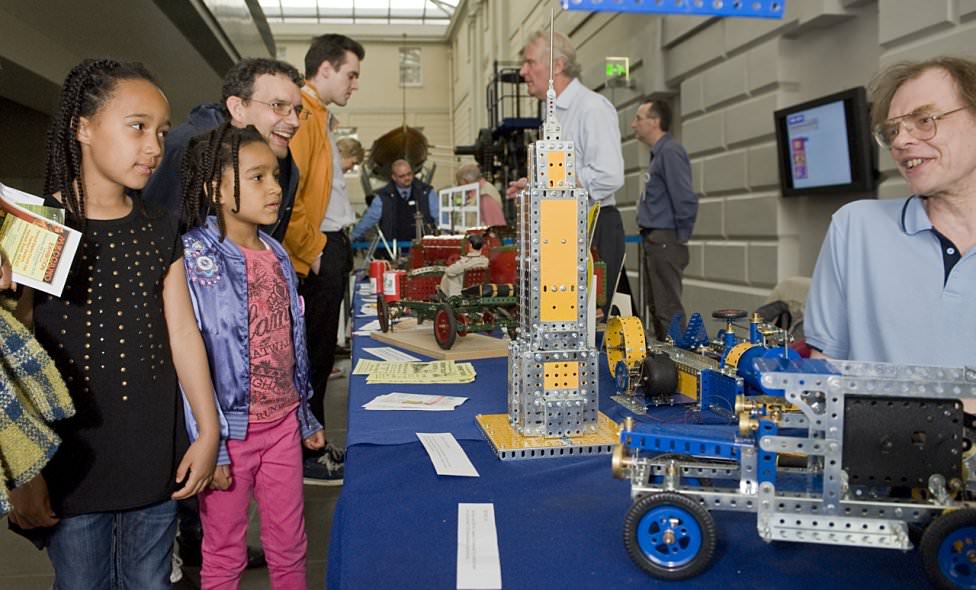
Brian Elvidge amuses one family (Photo: NMM)
Frank Paine as always put on a substantial display of models, sets, Meccano Magazines and showcards of period models and prototypes. His № 10 set ‘Schools’ class locomotive took pride of place, with its wheels and motion work turning at the press of a button, like his SML1 motor chassis. These models impress spectators seeing them for the first time but never lose their appeal. I could see young people fascinated when they could work a gear lever and actually see what happens — just what Frank Hornby intended! Frank also had a biplane from the Aero constructor series, a ‘Royal Sovereign’ battleship and 1931 4A outfit nestling temptingly in its box.
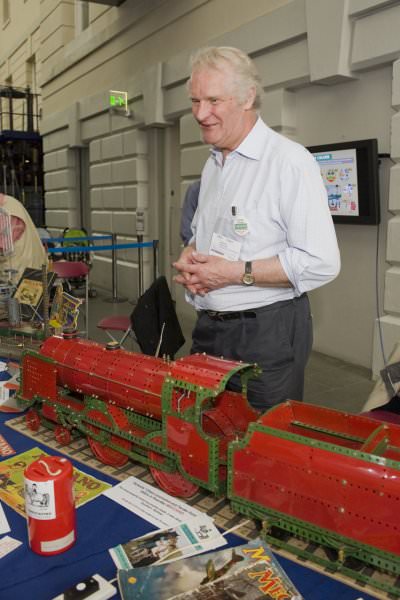
Frank Paine with his locomotive (Photo: NMM)
Brian Leach brought his motorised ‘Ames Window’ illusion which kept spectators’ attention. I must confess I found myself frequently mesmerised by it — it never loses its effect. Was it rotating, reversing or changing its shape? Despite Brian’s instructions to view it from a distance, people kept peering from a few inches away — out of fascination no doubt.
Douglas Windibank had an appealing exhibition of period style models. A biplane, crane and lorry crane all came from the Marks and Spencer ‘vintage’ sets which, although wildly inaccurate historically, gave a good impression of early (pre flexible plate) 1930s models. He also had a steam wagon from set 5 plus a Magic motor which had a good turn of speed.
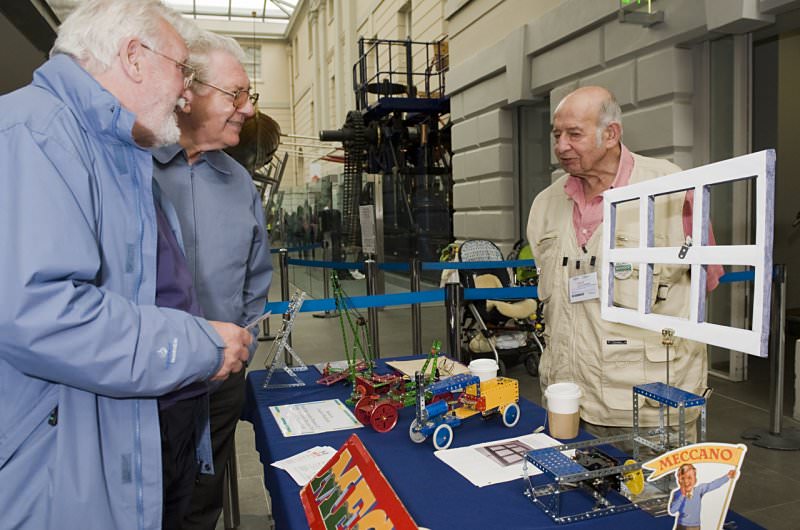
Douglas Windibank chats to visitors (Photo: NMM)
To sum up: The exhibition went well and seemed to be well attended. It appealed to children, parents and grandparents alike many of whom, given the nature of the venue which is a listed tourist attraction, came from abroad. As at Kew Bridge Steam Museum, museum venues have a lot to recommend them. The reaction of the National Maritime Museum staff to our display was, as I said, very encouraging and appreciative and it is to be hoped this is not the last time our hobby is represented there.
Even the weather co-operated, not being fine enough to draw spectators to the coast, etc. Unfortunately it let us down towards the end, our loading and leaving being done under torrential rain — a small price to pay for a worthwhile day.
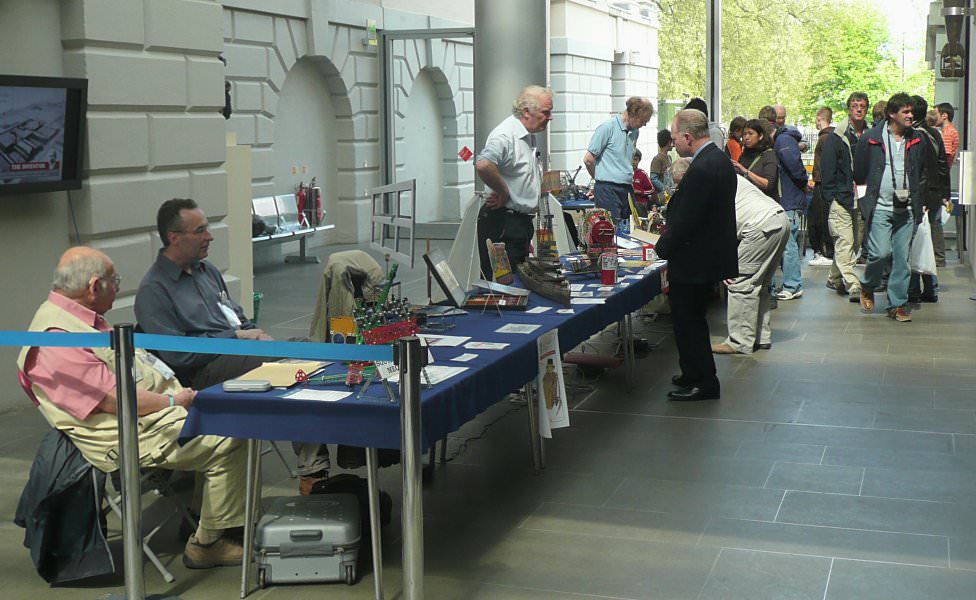
Another view of our exhibition